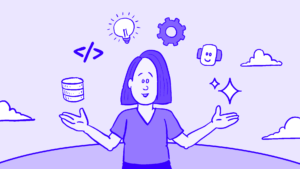Great Boards: Blake Eskin
A professor from The New School’s Journalism + Design program talks about how he uses Aboard in the classroom.

Blake Eskin is an assistant professor and the chair of Journalism + Design at Eugene Lang College of Liberal Arts at The New School. He also helps organizations start podcasts, and is developing an app for teaching healthier news habits.
How did you first learn about Aboard?
I’ve known Paul Ford since he was the web editor of Harper’s Magazine and I was the web editor of The New Yorker. I saw Paul was up to something new, and I was curious—and I like playing with new software. So I tried Aboard myself, and I thought it was an interesting tool.
Want more of this?
The Aboard Newsletter from Paul Ford and Rich Ziade: Weekly insights, emerging trends, and tips on how to navigate the world of AI, software, and your career. Every week, totally free, right in your inbox.
Also, I have this project called Share A Story. It’s an app that supports a daily practice for students to cultivate more conscious—and ideally healthier—news habits. They choose a story once a day, describe it, and share it with their classmates. I’d already built a prototype of Share a Story using another database tool, but I could see immediately how easy it would’ve been to prototype it using Aboard, especially with the Chrome extension.
I liked Aboard, and I decided to try it with my students.
How do you evaluate software to bring into the classroom?
I know what works well for me, but I don’t always know what works well for students.
One of my big complaints about academic software is that it’s enterprise software. An LMS— that’s the learning management system—is sold to the CIO. It’s got every possible feature that anyone could ask for, and yet there’s no way to do anything easily. And there are so many ways to do things. No professor uses the LMS in the same way; there are professors who code and others who insist on paper printouts. I suppose this is a form of academic freedom, but it is a cognitive burden on students.
So I’m wary of introducing new software to students, because they’re like, “Oh no. One more system that I have to learn.” Just like the faculty, there are some students who get new software and some who have a much harder time with it—people who can play with it, and people for whom it’s just demoralizing.
I try to teach them that it’s not their fault. On the first day of my intro class, I quote Amber Case: “We are not bad at technology, technology is bad at us.” And every time we try a new program, I make sure to spend a few minutes reflecting on how that program made everyone feel and whether it was “bad at them”—to become more aware of their “user experiences” and think critically about the software they use.
When I do insist on an application they’re not used to, I try to explain why I’m doing it. For example, I make my students use Slack instead of the discussion boards on Canvas because people in journalism- and design-adjacent fields use Slack in their work. So I explain that a fluency with Slack will be a job skill.

So how did you introduce Aboard into your classroom?
I was teaching a first-year seminar called “Journalism About Higher Education.” The idea is basically, most higher-ed coverage doesn’t reflect what most students care about, but they become these defining stories. So I had students look at the New York Times, the Wall Street Journal, the Washington Post, and ask, what are they writing about?
You had the students save those stories to Aboard?
Yes. We do clustering design exercises, and Aboard seemed like a really good tool for that. We collected dozens of stories, and I said, “Each of you make a stack with three to six stories you think are related, and give the stack a name.” There’s “the anti-woke movement.” There’s “access to education.” There’s “community college.”
And then I ask them, “What’s a story that you don’t see on the board—what’s missing here?” And then I have them pitch that missing story.
You immediately thought about Aboard as a collaborative tool?
Yes. Students may be using software that’s really good at collaborative activity, but it can be hard to get them to actually collaborate. I do some Post-It Note exercises—and I know there’s a lot of discourse about the superficial nature of design thinking, but to me, the great thing about the Post-It Note exercise is you get your ideas out there and they become communal property, and other people can do things with them. And that’s what I liked about Aboard, too.
When we used Aboard, I didn’t say, “Make a stack of your stories.” I said, “Make a stack of stories. Take a bunch of cards that fit together.” So it’s the same kind of thing as the Post-It Notes—here’s a bunch of communal property. What are the patterns we’re seeing here? This was a lesson in the flexibility of organizing information. In journalism as well as a lot of other fields, developing that pattern identification is important. I also teach students to use an RSS reader; I try to encourage collecting and pattern matching.
One of the things I learned during the pandemic is that if you can have a good experience in, say, a Google Doc together, it actually feels like co-presence—it feels more connected than listening to a teacher on Zoom, and sometimes more than listening to a teacher in the classroom. I think people need to learn how to collaborate; I think work is about collaborating—let’s make something together.
Are you planning on using Aboard with your students this semester?
Yes, I’m planning to try this again with them. The new AI features are also an opportunity for teaching. We’ll look at some of those features and evaluate them, because students need to get in the habit of verification and double-checking. I think it’s cool that it’s able to scrape more categories and fields, too.
I also teach a course called “Journalism and the Machine,” about how new technologies can transform journalism as well as the role of the journalist. We talk about machine learning, but also about the impact of technologies like the telegraph and the fax machine. LLMs may be the shiny new thing—and the most threatening one to journalism students, because of their ability to produce plausible writing and images so quickly.
But the original impetus behind this course was actually the recent profusion of no-code and low-code tools, which allow you to do computational things, to do boring tasks repeatedly, without having to learn Python or JavaScript. And to teach algorithmic thinking even though I don’t have the coding chops of someone like Paul—I’d call myself a scripter, not a coder.
So no-code or low-code tools make algorithmic journalism projects more accessible to liberal arts students. They open up a lot of possibilities for reporters who think of themselves mainly as writers.


